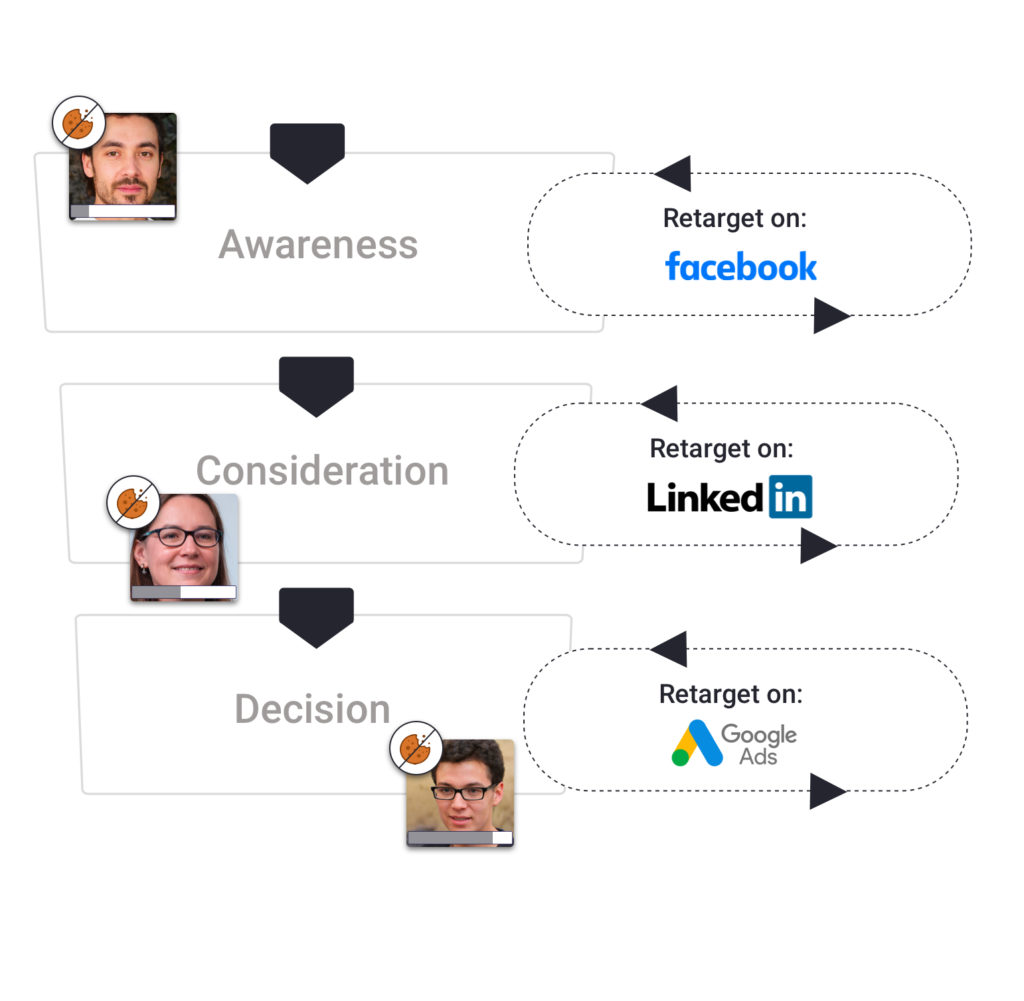Retargeting Advertising Worst Practices: What Marketers Should Never Do


Retargeting advertising is a powerful tactic that offers brands a second chance to engage with potential customers who have previously interacted with their online content. As consumers navigate the vast landscape of the internet, retargeting becomes a guiding beacon, rekindling interest and nurturing relationships. However, the effectiveness of retargeting campaigns hinges on a delicate balance – a balance between engaging users strategically and avoiding practices that may lead to fatigue or, worse, alienation.
These are some common pitfalls of retargeting advertising, and how to avoid them.
Overly Aggressive Frequency: Navigating the Thin Line
One of the most common mistakes in retargeting advertising is the temptation to overwhelm users with an excessive frequency of ads. Bombarding users with too many retargeting ads can swiftly transform what could have been a compelling engagement into an annoyance, leading to ad fatigue and, ultimately, counterproductive outcomes.
Understanding the user’s digital journey is crucial; each interaction should be a step toward conversion, not a push toward frustration. Overly aggressive frequency not only risks alienating potential customers but can also damage the brand’s reputation and diminish the effectiveness of the retargeting strategy.
How to solve it:
- Implement Frequency Capping: Set limits on the number of times a user sees your retargeting ads within a specific time frame. This prevents excessive exposure and helps maintain a balance.
- Utilize Optimal Ad Frequencies: Research and industry benchmarks can guide you in determining the optimal frequency for your retargeting ads. Consider factors such as the nature of your product and the typical customer journey.
- Consider the Customer’s Stage: Tailor your ad frequency based on where the user is in the conversion funnel. For example, users in the awareness stage might tolerate more frequent exposure than those closer to making a purchase decision.
- Regularly Review and Adjust: Monitor key performance indicators (KPIs) such as click-through rates and conversion rates. If you notice a decline, be prepared to adjust your frequency strategy accordingly.
Lack of Variety in Ad Creatives: Breathing Life into Campaigns

As we’ve just seen, in advertising monotony is the enemy. Displaying the same ad repeatedly not only risks inducing ad fatigue but can also prompt users to actively block or ignore your messaging. The consequence? A diminishing impact on your target audience and, potentially, a wasted advertising budget.
Humans crave novelty, and the digital landscape is no exception. When users encounter the same ad ad nauseam, their interest wanes, and the once-engaging content becomes background noise. Lack of variety in ad creatives can undermine the entire purpose of retargeting — rekindling interest and nurturing leads.
How to solve it:
- Create a Diverse Creative Portfolio: Develop a range of ad creatives with distinct visuals, messaging, and calls to action. This diversity not only maintains user interest but also allows you to test which elements resonate best with your audience.
- Rotate Ad Formats: Experiment with different ad formats, such as static images, carousel ads, and videos. Each format brings a unique dynamic to the user experience and helps combat monotony.
- Highlight Different Product Benefits: If you’re retargeting based on specific products or services, showcase different benefits or use cases in your ad creatives. This provides users with new reasons to engage.
- A/B Test Creatives Regularly: Implement A/B testing to assess the performance of different ad creatives. Use the insights gained to refine and optimize your creative strategy over time.
- Stay Seasonally Relevant: Integrate seasonal themes, promotions, or relevant trends into your ad creatives. This not only keeps content fresh but also demonstrates your brand’s responsiveness to the changing landscape.
Ignoring Time Sensitivity: Crafting Timely Retargeting Strategies

Ignoring the temporal dimension of your campaigns can lead to critical missteps, such as bombarding users with ads for a product they’ve already purchased. This oversight not only risks diminishing the user experience but may also create a sense of intrusion and disconnect.
The essence of retargeting lies in reengaging users at strategic points in their journey. Failing to align your retargeting efforts with the user’s timeline can result in misfires, where your messaging becomes irrelevant. This can erode trust and tarnish your brand image.
How to solve it:
- Implement Intent-Based Retargeting: Leverage intent triggers with Pathmonk Retargeting to display ads that are dynamically generated based on the user’s real-time interactions with your website or app. This ensures that your ads evolve in real-time with the user’s behavior.
Supercharge your ads' ROI without cookies
Boost your ads performance with cookie-free ads that retargets users based on their real-time intent.

- Set Expiration Dates for Campaigns: Establish expiration dates for your retargeting campaigns. This is particularly crucial for promotions, ensuring that users are not exposed to ads for expired offers.
- Regularly Review and Adjust Campaign Duration: Periodically assess the duration of your retargeting campaigns. If users are still being retargeted long after their last interaction, it might be time to adjust your time frames for a more accurate and user-friendly approach.
Incomplete Audience Segmentation: Unlocking the Power of Precision
Every user is unique, and their online behaviors and preferences vary. Treating your entire audience as a monolithic entity overlooks the opportunity to tailor your retargeting messages to specific interests, demographics, and behaviors. Incomplete audience segmentation can result in users being served ads that don’t align with their needs or stage in the customer journey.
How to solve it:
- Leverage Demographic Data: Incorporate demographic information, such as age, gender, and location, into your segmentation strategy. This allows you to deliver content that resonates with the unique characteristics of different user groups.
- Segment Based on Purchase History: Divide your audience according to their purchase history. This segmentation can include loyal customers, one-time buyers, and those who have yet to make a purchase, enabling you to craft targeted messages that suit each group.
- Tailor Segmentation to Campaign Objectives: Align your segmentation strategy with the specific goals of your retargeting campaigns. For instance, if you’re promoting a new product, segment users who have shown interest in similar products in the past.
Discounting Cross-Device Tracking: Bridging the Gaps in User Journeys
Modern consumers are fluid in their device usage, seamlessly shifting from desktops to smartphones and tablets. Ignoring this cross-device fluidity leads to missed opportunities and a disconnected retargeting narrative. Without cohesive tracking across devices, users may encounter the same ad repetitively on one device while being entirely unaware of it on another, resulting in a disjointed and ineffective retargeting strategy.
How to solve it:
- Implement Cross-Device Advertising Tools: Leverage advanced tools such as Pathmonk Retargeting that enable seamless cross-device tracking. This ensures that user interactions are recognized and connected across desktops, mobile devices, and other platforms.
- Create Unified User Profiles: Develop unified user profiles that aggregate data from various devices. This holistic approach allows you to understand the complete user journey and deliver a cohesive retargeting experience.
- Responsive Ad Design: Craft retargeting creatives that are responsive to different screen sizes and formats. A seamless visual experience across devices enhances user engagement and reinforces the continuity of your retargeting message.
Invasive Third-Party Cookies: Balancing Personalization and Privacy
In the pursuit of personalized retargeting, the reliance on invasive third-party cookies poses a considerable risk. While personalization is a cornerstone of effective advertising, crossing the line into the realm of invasive tracking methods can spark privacy concerns among users. Platforms that heavily depend on cookies for retargeting not only raise ethical questions but may also encounter resistance from individuals wary of potential data misuse.
As privacy concerns become more prominent in the digital landscape, users are increasingly protective of their online data. Invasive third-party cookies can be perceived as a breach of this trust, potentially alienating your audience. Striking a balance between personalization and privacy is essential for maintaining a positive brand image and fostering a trusting relationship with users.
How to solve it:
- Explore Cookieless Retargeting Solutions: Embrace cookieless retargeting solutions that prioritize user privacy. Pathmonk Retargeting offers an alternative that doesn’t rely on invasive third-party cookies, ensuring a more respectful approach to user data.
- Utilize First-Party Data: Leverage first-party data obtained directly from user interactions with your brand. This type of data is generally more accepted by users and can be used to personalize retargeting efforts without the privacy concerns associated with third-party cookies.
- Anonymize User Data: If collecting user data is necessary, anonymize it to remove personally identifiable information. This approach allows for personalization without compromising individual privacy.
Stay Compliant with Regulations: Keep abreast of data protection regulations, such as GDPR and CCPA, and ensure that your retargeting practices align with these standards. Compliance not only mitigates legal risks but also demonstrates your commitment to respecting user privacy.
Neglecting Analytics and Optimization: The Imperative of Continuous Improvement

Failing to regularly scrutinize the performance of your retargeting campaigns and leverage analytics for insights can lead to wasted ad spend and missed opportunities for refinement. Without a keen eye on the data, the potential for improvements diminishes, and your retargeting strategy may fall short of its maximum effectiveness.
How to solve it:
- Set Clear Key Performance Indicators (KPIs): Define specific KPIs that align with your retargeting objectives, such as click-through rates, conversion rates, and return on ad spend. These metrics serve as benchmarks for performance evaluation.
- Regularly Monitor Campaign Metrics: Establish a routine for monitoring campaign metrics. Regular checks allow you to identify trends, spot anomalies, and swiftly respond to changes in campaign performance.
- Utilize Analytics Platforms: Leverage robust analytics platforms, such as Pathmonk Intelligence, to gain in-depth insights into user behavior, engagement, and conversion paths. These tools provide valuable data for informed decision-making.
- Implement Testing: Conduct A/B testing on different elements of your retargeting campaigns, including ad creatives, copy, and targeting parameters. Analyze the results to understand what resonates best with your audience and refine your approach accordingly.
- Adjust Budget Allocation Based on Performance: Continuously assess the return on investment for different aspects of your retargeting strategy. Adjust budget allocations to prioritize channels or creatives that yield the best results.
- Stay Informed on Industry Trends: Keep abreast of industry trends and changes in consumer behavior. Adapting your retargeting strategy to align with these shifts ensures relevance and effectiveness in an ever-changing digital landscape.
- Iterative Optimization: Treat optimization as an iterative process. Make incremental adjustments based on data analysis rather than radical overhauls. This approach allows for continuous improvement while minimizing the risk of disruption.
Conclusion
Navigating the realm of retargeting advertising demands a strategic approach, marked by careful consideration of best practices and a keen awareness of what to avoid. As we’ve explored the worst practices in retargeting, it is evident that oversaturation, indiscriminate targeting, and intrusive methods can not only compromise the user experience but also tarnish a brand’s reputation.
Marketers must recognize that retargeting is a delicate balance between persistence and annoyance, and respecting user privacy is paramount. By steering clear of aggressive tactics, such as bombarding users with excessive ads or following them incessantly across the internet, brands can build trust and foster positive connections with their audience





